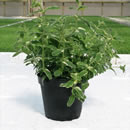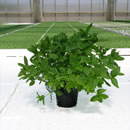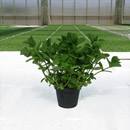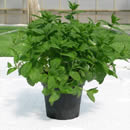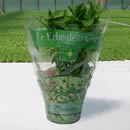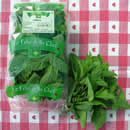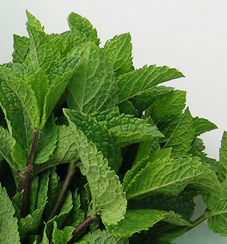Mint
Dill
Absinthe
Basil
Borage
Calamint
Capers
Chervil
Coriander
Tarragon
Chives
Wild fennel
Lavender
Lovage
Lippia Citriodora
Marjoram
Lemon balm
Mint
Myrtle
Oregano
Chilli pepper
Salad burnet
Parsley
Rosemary
Garden rocket
Rue
Sage
Celery
Thyme
Valerian
HISTORICAL HINTS: Lamiaceae family. The genus Mint, native to the temperate areas of the Mediterranean, has naturalized also in Europe and Asia and it can be also commonly found in northern America and Australia. Mint has been grown for its officinal properties since very ancient times; it was found in Egyptian tombs dating back to 1000 B.C. and some documents testify that in Japan menthol has been extracted from this plant for at least two millenniums. Mint is cited in the Bible as one of the essences to pay the tithe, while Charlemagne, interested in herbal uses, ordered that mint should be grown in its Empire. This plant accompanied the Romans in their conquests and from the Great Britain it also reached America thanks to the settlers. Its name comes from the Greek; according to the legend the God of the underworld, Pluto fell in love with a nymph called Minthè and that the jealous Persephone's wife transformed her in a plant for revenge.
THE PLANT - Mint (genus Mentha) is an aromatic herb belonging to the Lamiaceae family and can be found in different species: peppermint, penniroyal, water mint, horse mint, etc... Peppermint is a hybrid obtained after the breeding of water mint and spearmint and is one of the most used and known. Peppermint is a very resistant herbaceous perennial plant easy to spread. Mint grows up to 1 m, with erected stems and small white or purple-pinkish flowers which are gathered in a thick conic spike on top of the stems. It has oval, dark green leaves with toothed edges that spread a strong aroma if rubbed, hence its definition as an aromatic herb. The fruit contains 1 to 4 seeds. Mint usually grows in plain but it can be found up to 700 m on the sea level, provided that it is exposed to the sunlight (half exposition) but not to the wind. Mint leaves are harvested in June and flowered tops in July and August since blossoming takes place from summertime to autumn.
VARIETIES
Mentha acquatica: it grows spontaneously in Italian humid areas; flowers are globular and blossom from June to September.
Mentha arvensis: it grows spontaneously in Tuscany and Abruzzo (Italian regions) and has quite long leaves.
Mentha longifolia: it grows spontaneously in all Italian regions; it has oval leaves, 40 to 80 cm tall; spike flowers are white or pink.
Mentha X piperita: this hybrid between water mint and spearmint is native to England and is one of the most common among its species. Peppermint is very common in northern Italy where it is used to extract oil to be used in confectionery industries and in pharmacy.
Mentha pulegium: also called pennyroyal, not taller than 40 cm and very common in all Italy.
Mentha rotundifolia: it grows in bushes in all Europe and has small rounded-shaped leaves with whitish hairs.
Mentha spicata: also called spearmint; it grows almost exclusively in humid areas. It has reddish stems, long leaves and pinkish flowers and it is one of the most grown in Great Britain but it is also commonly found in northern America and Italy.
Maroccan mint: native to Morocco.
Pineapple mint: with a pineapple aftertaste.
PROPERTIES - mint essential oil contains menthol which calms straight muscular tissue of the digestive apparatus and relaxes intestine with its spasmolythic, antiseptic properties and it also lessen pains provoked by a gas excess. In strong gastrointestinal pains, it develops the same calming action of 1-2 cg of morphine thanks to its digestive properties. It is also decongestant and balsamic and it fluidifies secretions from the respiratory system. Its sedative and antiemetic properties makes it a good remedy against car sickness, seasickness, airsickness and can stop nausea in a very small amount of time. It also has antipruritic properties which makes it an excellent remedy against mosquito and other insect bites besides being very useful to regularize the menstrual cycle and the flux and to relieve from pains. Its essence is very useful to refresh and deodorize breath, and thanks to its antiseptic and anti-inflammatory properties it is an efficient remedy to cure mouth ulcer and stomatitis, eczema, ringworm, scabies, ulcer, herpes zoster, dermatitis. Peppermint essential oil is advisable for many neurovegetative problems as anxiety, insomnia, vertigos, depression, tachycardia, and migraine. Mint leaves have astringent and purifying effect and cure irritations, thus they are used to prepare face masks. Mint is contraindicated in case of esophagitis, hepatitis, and favism. It is not advisable to take big doses of mint essential oil together with other homeopathic cures, because it may interact and impede the action of homeopathic drugs, and it is equally unadvisable to take pure essential oil for external use because it may have an irritating effect. Those who are affected by gastritis, ulcers and gallstone shouldn’t take mint because it causes an increase in gastric secretion production; in addition, if taken in big doses for long periods it may cause insomnia and it could be nephrotoxic. Children, pregnant and breast-feeding women should not use essential oil which should be used carefully since it can have stupefacient effect if taken in big doses, provoking anxiety, shivers, convulsions, and a strong depression. Care should be also taken with pure menthol: it is toxic and even a single teaspoon can be lethal, while essential oil may cause heart trouble; menthol should not be given without medical prescription, since it causes allergic and irritating reactions.
CULINARY USE - Using mint as ingredient is very common in Italy, Spain, India, Middle East and Northern Africa. Because it has a very strong flavour, its use should be controlled but it represents a very good match with all kind of meats and especially with lamb, duck, and mutton. Its fresh aroma makes it an excellent match also with summer vegetables: tomatoes, cucumber, new potatoes, eggplants, zucchinis and it can be also added to fruit salads and to different sweets. Dried mint is used to prepare infusions and to aromatize other drinks, to make candies, chewing gum, syrups and different liquors and cocktails as mojito where it is pestled with cane sugar, ice and rum.























